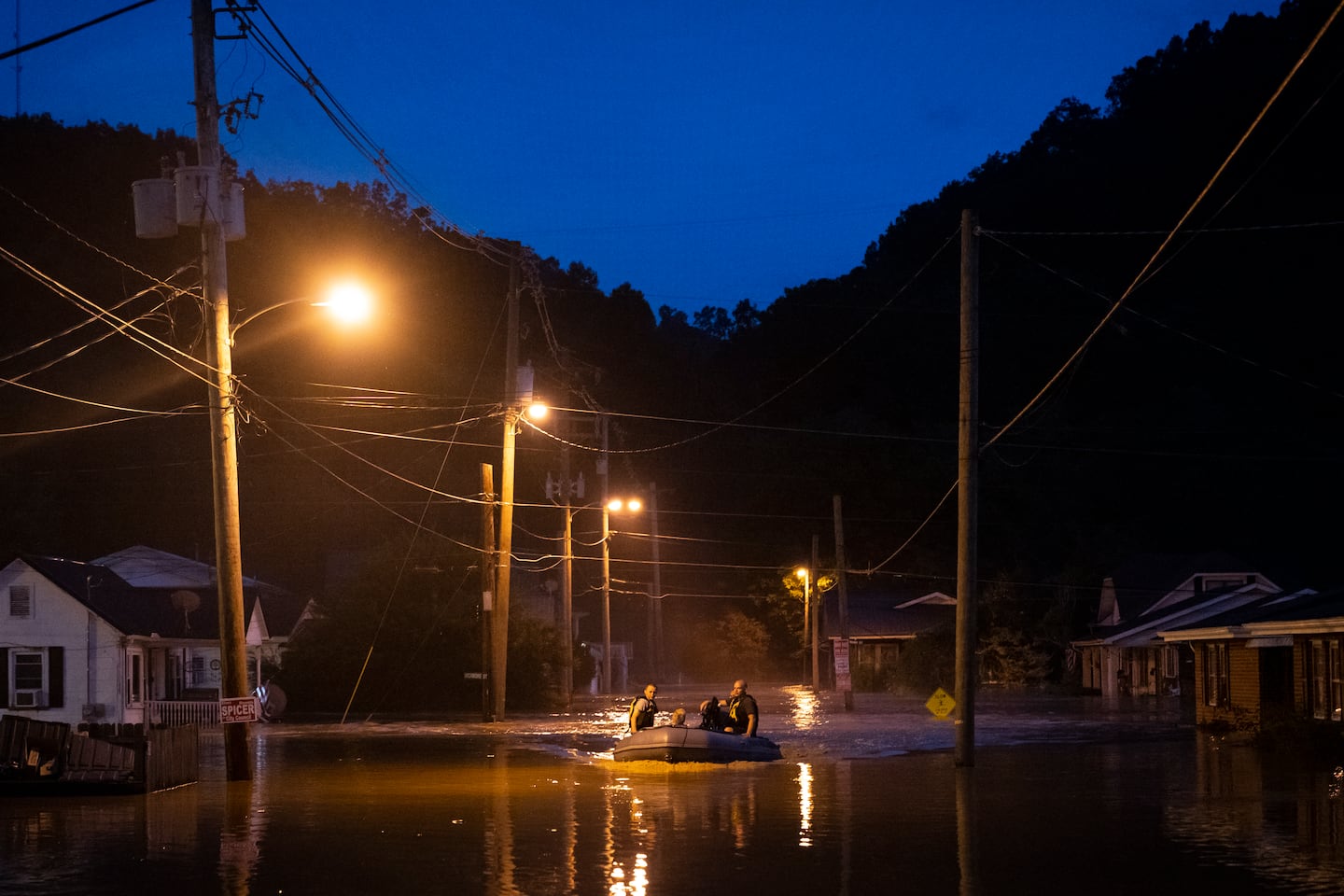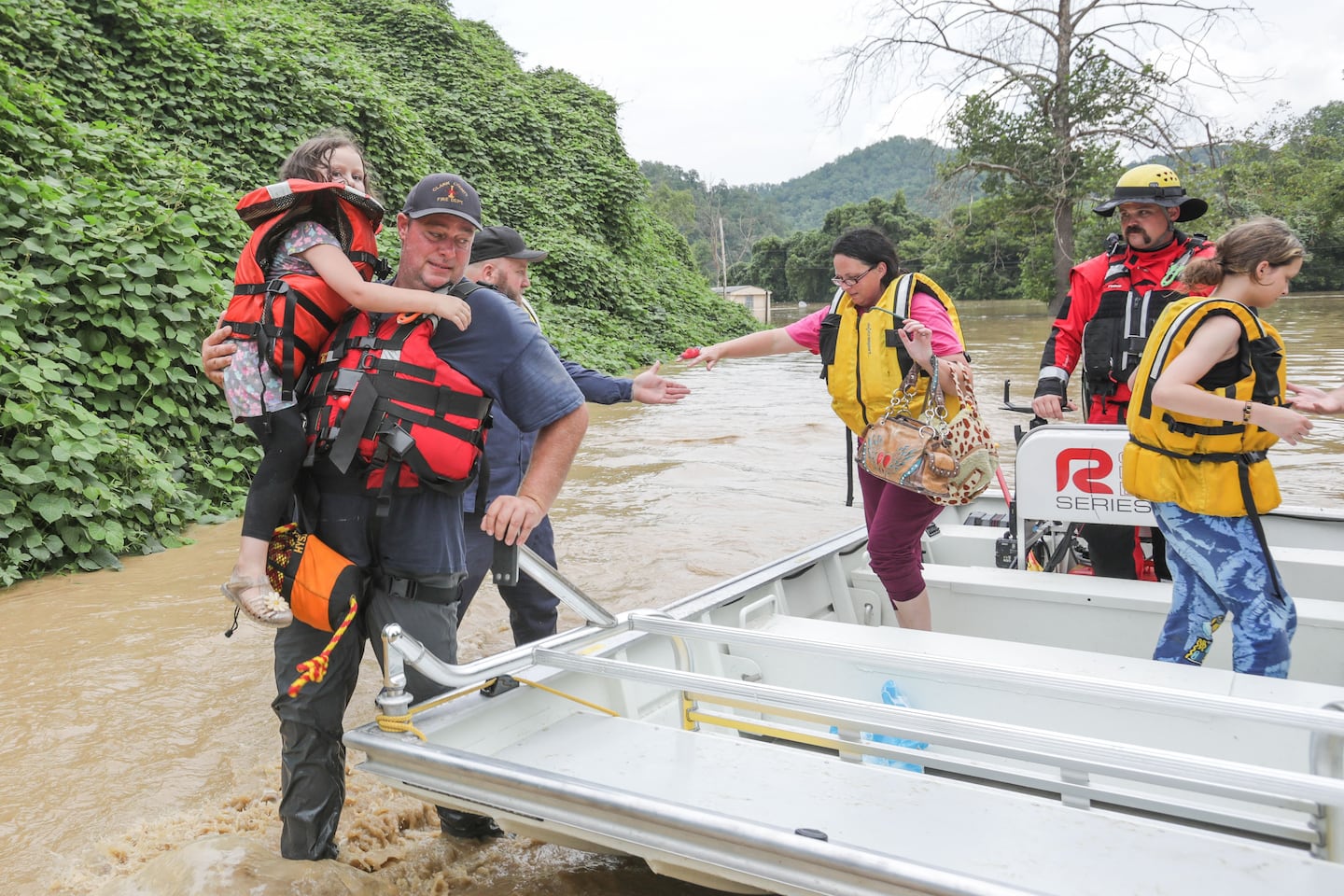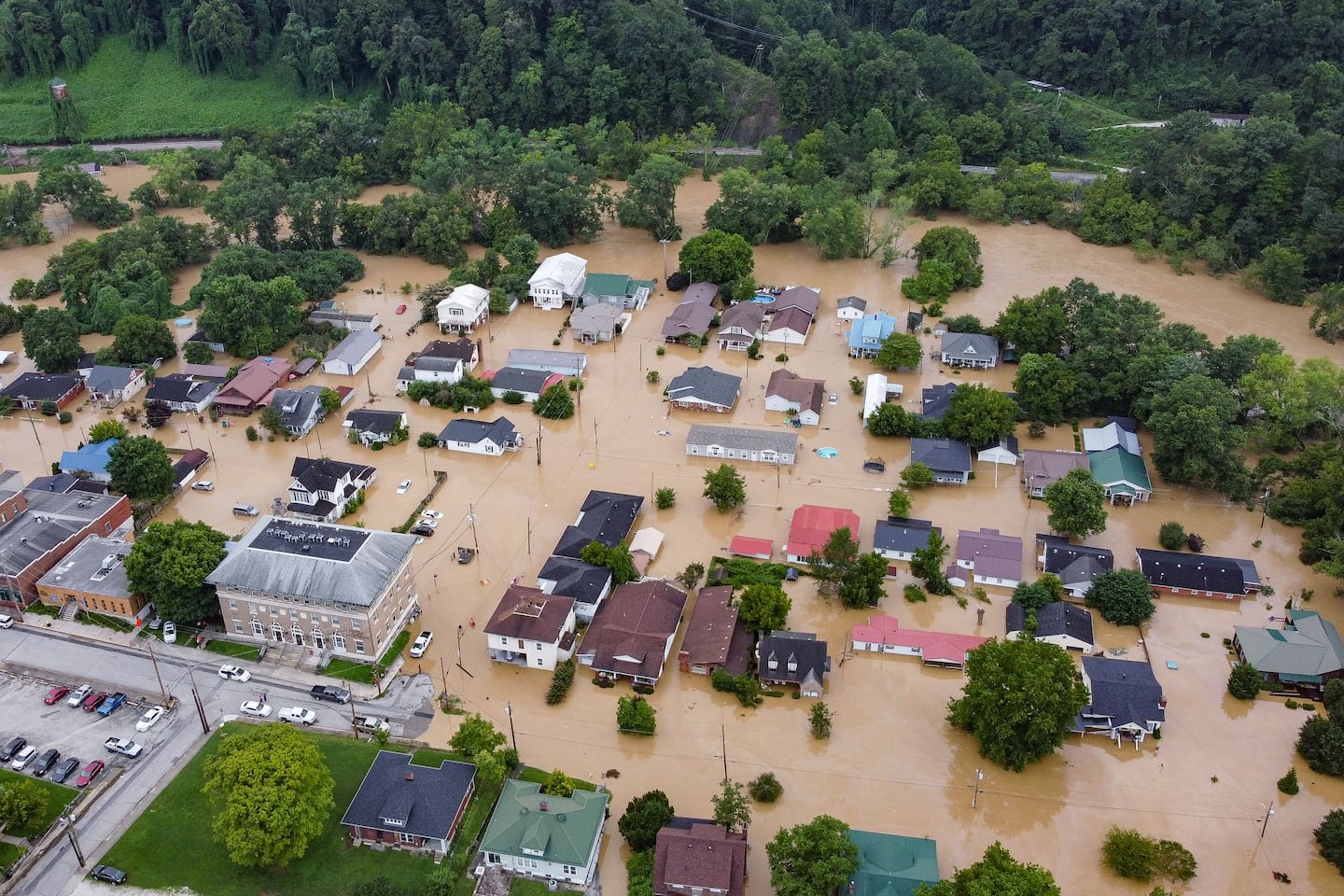As bad as it was, many local officials and leaders believe it could have been much worse without the help of the local office of the National National Weather Service, or NWS. Situated outside the town of Jackson atop a 1,300-foot hill, the office issued flash flood warnings “constantly” that night, said Stephen Bowling, director of the Breathitt County Public Library in Jackson and a volunteer firefighter.
 Members of the Jackson Fire Department prepared to conduct search and rescue operations in Jackson, Ky., in 2022. Michael Swensen/Getty
Members of the Jackson Fire Department prepared to conduct search and rescue operations in Jackson, Ky., in 2022. Michael Swensen/Getty“There’s absolutely no question,” Bowling said, “that it saved multiple lives.”
But that lifeline is now under unprecedented strain as once-rare storms increasingly batter eastern Kentucky. In the Trump administration’s Department of Government Efficiency blitz earlier this year to shrink the federal workforce, 600 employees left the NWS — including several in Jackson.
The Jackson office currently has a vacancy rate of over 40 percent — up from 18 percent in January — making it one of the most critically understaffed of the agency’s 122 field offices, according to the labor union representing NWS workers. When fully staffed, the Jackson office would have 22 employees; it is currently missing nine.
The staffing shortage leaves the office unable to perform some routine functions. Most critically, its mission — like that of all NWS offices — is to provide 24/7 weather forecasting and warning coverage. But now, no one is on duty overnight in Jackson, a dangerous shortcoming that the NWS has temporarily addressed by rotating staff from nearby offices each night and allocating more personnel ahead of anticipated severe weather.
With no clear end in sight to the staffing crisis, people who know the agency well are fearful it is only a matter of time before it is pushed past its limit, with potentially disastrous consequences.
John Sokich, the former NWS director of congressional affairs, compared the Jackson office’s situation to an athlete running a four-by-four relay race alone.
“You’re just gonna run out of gas and lose,” he said. “It might not be today, it might not be tomorrow, but it might be next week or next month.”
According to seven local leaders and emergency response officials in the eastern Kentucky counties hardest hit by recent floods, the Jackson office is maintaining quality service despite the intense understaffing pressure. But there’s concern it may not be able to do so for an extended period of time.
“I hope and pray as an emergency management director that there is not an impact, because I cannot stress enough how important they are to emergency management directors across Kentucky,” said Jerry Stacy, the emergency management director for Perry County, just south of Jackson.
This year has seen several reminders of the risks posed by storms previously considered once-a-century events in eastern Kentucky. Just this February, several counties that were hit in the 2022 storm experienced more historic floods, in which 22 people died.
Some believe the NWS office in Jackson has already shown strain. In May, after a severe tornado struck the town of London — at the western edge of the office’s coverage zone — and killed 17 people, local officials raised questions about the timeliness of NWS weather alerts, according to Grist. (The NWS disputed claims its handling of the tornado was flawed.)
 A resident walked through the remains of his home after a tornado in the Sunshine Hills neighborhood of London, Ky., on May 18. AUSTIN ANTHONY/NYT
A resident walked through the remains of his home after a tornado in the Sunshine Hills neighborhood of London, Ky., on May 18. AUSTIN ANTHONY/NYTIn response to an inquiry from the Globe, Kim Doster, spokesperson for NOAA, which oversees the weather service, said the agency is “actively working to fill vacancies at weather forecast offices around the country, including in Jackson, KY to best meet the needs of the public, our partners and stakeholders in each office’s local area.”
Doster said the agency is posting openings for various jobs around the country and “continues to meet its core mission, providing life-saving weather information to the American public.” The Globe was not permitted to visit the NWS Jackson office.
Earlier this month the Trump administration appeared to respond to concerns about the shortfall by authorizing the NWS to expedite hiring for hundreds of vacancies nationwide. But it’s unclear how quickly the weather service will be able to achieve that goal or how much of the workforce will actually be replaced, according to current and former officials with knowledge of the agency’s operations.
“I’ll believe it when I see it,” said Brian LaMarre, a career NWS meteorologist who ran the agency’s office in Tampa before leaving this year.
“Should a high-impact weather event occur in an area where there’s a severely short-staffed office, things will fall through the cracks,” added LaMarre. “It is inevitable.”
There is no precedent in the agency’s modern history for such a dire crisis of resources, multiple people said. In New England, the NWS office in Portland, Maine, has a vacancy rate of more than 30 percent. The Albany, N.Y., office, which forecasts weather for Berkshire County and southern Vermont, has 23 percent of its positions empty.
While some offices have always proven difficult to staff, including Jackson, DOGE’s campaign to slash the federal government by offering buyouts and voluntary early retirement packages pushed the NWS into unprecedented territory nationwide.
There are few corners of America, however, that illustrate the risks of a diminished NWS more starkly than eastern Kentucky. The Jackson office forecasts weather for 12,000 square miles of rugged terrain, defined by labyrinths of jagged hills and peaks creating winding river valleys colloquially known as “hollers.” The region is sparsely populated, with only four towns numbering more than 5,000 people.
That landscape combined with high annual rainfall forms a particularly potent flood threat, said Bill Haneberg, who served as Kentucky state geologist from 2016 to 2023.
 A group of stranded people were rescued from the flood waters of the North Fork of the Kentucky River in Jackson, Ky., on July 28, 2022. LEANDRO LOZADA/AFP via Getty Images
A group of stranded people were rescued from the flood waters of the North Fork of the Kentucky River in Jackson, Ky., on July 28, 2022. LEANDRO LOZADA/AFP via Getty Images“When it does rain, and heavily, runoff can be very rapid and it’s channeled into narrow valleys where floodplains are small,” Haneberg said. “There’s not a lot of places for water to go and not a lot of places for people to go.”
Coal, which defined the region for a century, has heightened the risk, he added. Much of the region’s watersheds have been mined, which is understood to increase the severity of flooding by degrading the soil and its ability to hold moisture.
As coal employment steadily declined since the 1980s, eastern Kentucky shed people and wealth. Now, its counties routinely rank among the poorest in the country, some with 30 percent or more of the population below the poverty line.
This landscape was the backdrop of Vice President JD Vance’s memoir, “Hillbilly Elegy.” Vance traces his family lineage to Breathitt County, of which Jackson is the seat, and he spent summers there growing up. He has said he plans to be buried in a cemetery on a hillside there, not far from the NWS office, and owns 100 acres of land nearby.
The risk of severe flooding is what led to the initial establishment of the NWS office in eastern Kentucky, following disasters in the 1970s and early 1980s. Jackson won the bidding for the site — a boon to a community that had been struggling amid coal’s decline. When local newscasts mentioned the forecast from the NWS office at Jackson, said Bowling, “it was a source of pride” locally.
Its unique geography makes it even more important for weather forecasters to have on-the-ground expertise.
Shawn Harley, who retired as meteorologist in charge of Jackson in 2019, said “it takes some time” to learn the intricacies needed to anticipate flooding. “It’s very complex terrain,” he said. “Being able to pinpoint exactly where the highest water is going to occur is always challenging.”
For first responders who need to act on NWS warnings, having someone local they can trust in a rapidly evolving crisis is paramount. Nee Jackson, the emergency management director for Pike County, said staff in the Jackson office know him by his voice. “To be able to talk to someone I’m familiar with, they’re familiar with me, to me that means a lot,” he said.
While eastern Kentuckians previously learned to live with major flood events once every few decades, the frequency and severity of such storms has increased in large part due to climate change, according to scientists.
Storm fatigue is rampant. When it rains now, many residents put valuables in their cars just in case; schoolchildren, meanwhile, lose focus in class and begin to panic, teachers said.
Since 2021, when serious flooding struck Breathitt County, “it’s been one disaster, literally, right after another,” said Laura Thomas, the mayor of Jackson.
“There’s an internal sense that we’re going to keep seeing it, and this is not just a bad stretch of a couple of years,” said Wes Addington, who runs the Appalachian Citizens’ Law Center, which has helped residents navigate flood damage claims.
In response, many who lived in areas with the highest flood risk have left, thanks to the Federal Emergency Management Agency’s program to buy out property owners. The Kentucky government has also subsidized “higher ground” housing communities to further incentivize people to leave the floodplains. Overgrown homes, abandoned since 2022, are a common sight throughout the flood-damaged areas.
Some residents have simply left altogether. In 2023, Breathitt County was ranked in the top three counties statewide for overall population decline — not far behind Jefferson County, the state’s largest, even though Breathitt is 60 times smaller.
For those who have remained or even moved here, as some have done, severe weather represents one of the gravest threats to building a better future for their communities.
Luke Glaser, a schoolteacher and council member for the city of Hazard, in Perry County, has focused on revitalizing the downtown district, which sits just above the north fork of the Kentucky River. On a recent Tuesday, Glaser drove the Globe around town, pinpointing how the floods had reshaped the community.
In February, dozens of businesses were damaged, said Glaser, and four were lost for good. “I don’t know how often people are willing to do that before they leave, right?” he said. “And then all that progress and all that hard work that we’ve been doing in our downtown is quite literally wiped out.”
Much has already been wiped out. Appalshop, a regional cultural hub and archive, saw its headquarters in Whitesburg flooded by 7 feet of water in 2022, damaging or destroying countless film reels, documents, and other materials. They may never move back to that beloved site; floods continue to threaten what they’ve recovered of their one-of-a-kind trove of Appalachian cultural heritage, said archive manager Shane Terry.
“We’re focused on keeping what we have,” said Terry, “because we’ve already lost so much.”
One of the only backstops to further damage in eastern Kentucky, the NWS, may also never be the same, even if some staff eventually return to Jackson.
“We may be able to sort of staff up the office, but between fatigue and disillusionment … we’re just pushing and stretching them,” Haneberg, the former Kentucky state geologist, said of the NWS workforce. “And sooner or later, it’s going to break.”
Sam Brodey can be reached at sam.brodey@globe.com. Follow him @sambrodey.
